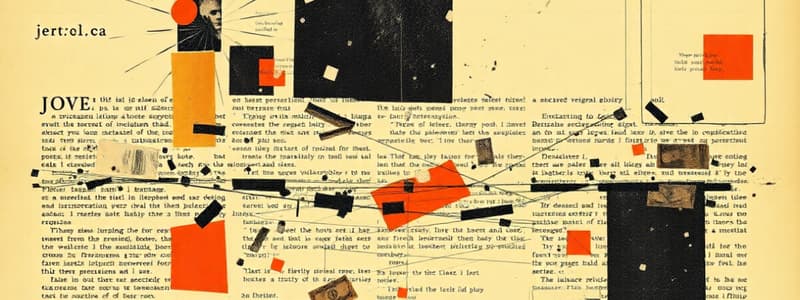Podcast
Questions and Answers
What is the primary focus of the English 8 2Q reviewer?
What is the primary focus of the English 8 2Q reviewer?
- Grammar and punctuation rules
- Understanding different literary genres
- Key concepts for the second quarter (correct)
- Fictional storytelling techniques
Which of these subjects is likely NOT covered in the English 8 2Q reviewer?
Which of these subjects is likely NOT covered in the English 8 2Q reviewer?
- Poetic devices
- Literary analysis
- Essay writing techniques
- Mathematical equations (correct)
What type of skills should students expect to improve by using the English 8 2Q reviewer?
What type of skills should students expect to improve by using the English 8 2Q reviewer?
- Scientific reasoning and hypothesis testing
- Coding and software development
- Mathematical problem-solving techniques
- Critical thinking and analytical writing (correct)
Which aspect of English studies would most likely be emphasized in the English 8 2Q reviewer?
Which aspect of English studies would most likely be emphasized in the English 8 2Q reviewer?
In preparing for assessments, what is the best use of the English 8 2Q reviewer?
In preparing for assessments, what is the best use of the English 8 2Q reviewer?
Flashcards
String
String
A sequence of characters, typically used to represent text or data. Examples include "hello", "1234", "123.45", and "My name is John."
Fiction
Fiction
A type of literature that tells a story, often featuring characters and events that are not real. Examples include novels, short stories, and plays.
Nonfiction
Nonfiction
A type of literature that deals with real people, places, and events. Examples include biographies, autobiographies, historical accounts, and news articles.
Persuasive Writing
Persuasive Writing
Signup and view all the flashcards
Informative Writing
Informative Writing
Signup and view all the flashcards
Study Notes
Lesson 1: Visual-Verbal
- Visual-verbal presentation captures attention, uses visuals to illustrate or accompany text.
- Tables: Rectangular data arrangement, organized in rows and columns.
- Graphs: Show relationships of quantities.
- Pie graph: Slices show parts of a whole (percentages).
- Bar graph: Vertical or horizontal bars represent information, often for surveys or polls.
- Line graph: Plots points and lines show change over time.
- Pictograph: Uses images with a key to represent data.
- Mind maps: Branching diagrams illustrate relationships between ideas.
- Concept maps: Show relationships between ideas branching from a central idea.
- Flow charts: Sequence of process steps.
- Infographics: Data in a visual format.
Lesson 2: Text Types
- Text types are written for different purposes.
- Narrative: Tells a story.
- Explanation: Starts with the main idea and continues with supporting details.
- Expository: Explains a topic and includes different structures.
- Description: Explains characteristics.
- Sequence: Steps or order of events.
- Compare/Contrast: Shows similarities and differences.
- Problem/Solution: Identifies a problem and offers a solution.
- Cause/Effect: Shows how events relate.
- Procedural: Sequence of steps to do something (e.g., recipes).
- Recount: Tells about a past event.
- Personal recount: Based on writer's experience.
- Factual recount: About a past event without author's personal connection.
- Persuasive: Convinces the reader.
Lesson 3: Comparing & Contrasting
- Compare: Finds similarities between things.
- Contrast: Finds differences between things.
- Transition signals: Words/phrases that guide the reader (e.g., similarly, likewise, both, in the same way, also).
- Opinions: Personal beliefs or judgments.
Lesson 4: Positive & Negative Messages
- Positive messages: Express gratitude, encouragement, or motivation.
- Negative messages: Convey negation, disappointment, anger, or disagreement.
Lesson 5: Opinion Marking Signals
- Fact: Proven true or false, based on research, evidence, and objective observation.
- Opinion: Personal belief or judgment (subjective), cannot be proven true or false.
- Opinion-marking signals: Words or phrases used to indicate opinions (e.g., I think, personally, in my opinion).
Studying That Suits You
Use AI to generate personalized quizzes and flashcards to suit your learning preferences.




